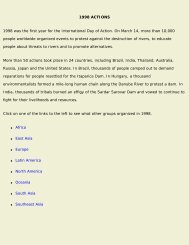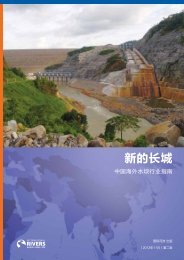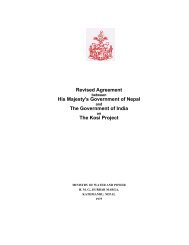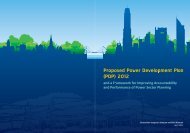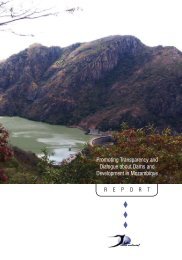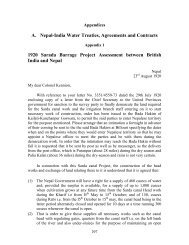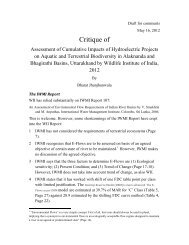Mountains of Concrete - International Rivers
Mountains of Concrete - International Rivers
Mountains of Concrete - International Rivers
You also want an ePaper? Increase the reach of your titles
YUMPU automatically turns print PDFs into web optimized ePapers that Google loves.
Box 5: Diamer-Bhasha Project, PakistanDam: 281 meter-high, 990 meter-long concrete gravitydamReservoir Area: 129.5 km 2Agricultural Land Submerged: 6.5 km 2Population Affected: 24,500 people in 2,833HouseholdsAffected Villages: 32Infrastructure Submerged: 110 km-long stretch <strong>of</strong>the Karakoram HighwayLand Required for Resettlement: 22.26 km 2Cost <strong>of</strong> Resettlement Program: US$200 millionSource: Press Briefing by WAPDA on 16 Dec. 2005, from website <strong>of</strong>the President <strong>of</strong> Pakistan http://www.president<strong>of</strong>pakistan.gov.pk/media/Water/WAPDA%20Brief.pps. The same presentation gives two differentfigures for affected population in two different slides. (Slide 41 gives23,700 people and 2,850 households as affected, whereas Slide 45 givesthe figures quoted.)and quality <strong>of</strong> flows. <strong>Rivers</strong> could run dry for a periodand then suddenly flood. Hourly, diurnal, and seasonalflows would change. Dams would trap silt behind them,depriving downstream areas <strong>of</strong> nutrients. All this is likely todramatically affect everything that depends on the river –daily water use, agriculture and irrigation, fisheries, wetlandsand mangroves, livelihoods, cultures and identities.The areas affected could range from the Indus Plains inPakistan to the Indus Delta, from the plains <strong>of</strong> the Ganga inIndia to the whole <strong>of</strong> Bangladesh, and would impact millions<strong>of</strong> people. The impacts would be local, regional and transboundary,with the cumulative impacts <strong>of</strong> dams in Nepaland India being felt all the way to Bangladesh. In Pakistan,the combined effect <strong>of</strong> the existing storage and diversionprojects on the rivers has already had a serious impact onthe Indus Delta. According to a study by the <strong>International</strong>Union for Conservation <strong>of</strong> Nature (IUCN), the flow in thelower Indus River decreased from 105,000 million cubicmeters (MCM) in 1932 to 43,000 MCM in 1970 as a result<strong>of</strong> the number <strong>of</strong> projects on the Indus and its tributaries.In the 1990s, the flow went down to 12,000 MCM. Thisled to a sharp reduction in the area <strong>of</strong> mangrove forests,declining fish production, degraded water quality, and severeencroachment <strong>of</strong> the sea into the delta area with a resultantloss <strong>of</strong> 4,856 km 2 <strong>of</strong> farmland. 87 New dams will aggravatesuch problems in the deltaic regions. Undoubtedly, thecumulative downstream impacts <strong>of</strong> dams in the Himalayasare going to be one <strong>of</strong> the most serious issues and needs tobe urgently studied in detail. It may be mentioned here thatdams planned in Tibet are likely to have many impacts fordownstream areas in Nepal, Bhutan, India and Bangladesh.Some <strong>of</strong> the projects in the Himalayas plan to divertlarge parts <strong>of</strong> river flows into tunnels. Such tunnels couldempty the flows into the same river many kilometresdownstream, or into another river. This will leave parts <strong>of</strong>the main stream virtually dry or with highly depleted flows.For example, the 300 MW Upper Karnali project on theKarnali River in Nepal will divert river flows through atunnel, leaving a 60 km-long stretch virtually waterless.Such diversion projects can disrupt fisheries, agriculture andother livelihoods dependent on the river. The impact willbe particularly severe when there is a cascade or series <strong>of</strong>such projects on a single river or in a single river basin. AsHimanshu Thakkar <strong>of</strong> the South Asia Network on Dams,<strong>Rivers</strong> and People (SANDRP) points out, there are sevenprojects under construction and nine proposed on theBhagirathi River and its tributaries in Uttarakhand, India. 88As a result, in large stretches between Gangotri and Haridwarthe river will flow through project-related tunnels, and therewill be no recognizable free flowing river as we know it.The same holds true for a number <strong>of</strong> other rivers likethe Satluj, Teesta, and Alaknanda. Bharat Jhunjhunwala, aneconomist and a resident <strong>of</strong> Bhagirathi Valley, estimates that<strong>of</strong> the 270 km <strong>of</strong> the Alaknanda River between Badrinathand Kaudiyala, 116 km will be affected by tunnels and 179km will be affected by either tunnels or reservoirs. 89Another dimension <strong>of</strong> the downstream impacts is theimpacts <strong>of</strong> the so-called run-<strong>of</strong>-river projects. Technically,run-<strong>of</strong>-river projects are projects without any storage orpondage. They use the flow <strong>of</strong> the water in the natural rivercourse, or sometimes through diversions like canals andtunnels, to generate electricity. They can have many <strong>of</strong> thetypical structures such as dams, weirs, headraces, tailraces,and diversions tunnels. 90Many Himalayan dams are being classified as run-<strong>of</strong>riverand hence are touted as socially and environmentallybenign; this is false. Many run-<strong>of</strong>-river projects can haveserious impacts by disturbing downstream river flows.Some run-<strong>of</strong>-river projects divert the water into tunnels,leaving downstream sections dry, and thus cause even moresevere impacts downstream. Many <strong>of</strong> the diversion projectsdiscussed above are classified as run-<strong>of</strong>-river.Furthermore, <strong>of</strong>ten projects with pondage to store waterfor meeting daily or weekly peaking needs are wronglyM o u n ta i n s o f C o n c r e t e : D a m B u i l d i n g i n t h e H i m a l aya s | 2 5




